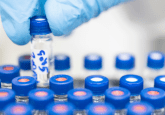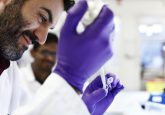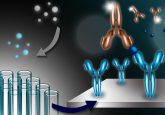Convergence of LBA/LC–MS in bioanalysis of large molecules – Part 2

Defining Hybrid LBA/LC–MS
In reviewing the literature, the phrase “Hybrid LBA/LC–MS” can be used to describe two different situations [1-13]. Both are appropriate, but the differences should be understood. The first description is specific to the selective isolation of the molecule of interest from the biologic matrix using an LBA followed by LC–MS analysis of the isolated analyte. The second description is broader and includes whenever both LBA and LC–MS technologies are applied within an overall program for a therapeutic biologic. This includes both hybrid assays as well as the use of LBA or LC–MS independent from one another – e.g., using LBA for the quantitation of total Ab from an antibody drug conjugate (ADC) and an LC–MS for the quantitation of the free and/or total small molecule component. This commentary is focused on the first description.
The basic concept of LBA/LC–MS is to extract/isolate the large molecule using an immunocapture based approach. The extract is then typically digested to the peptide level and a unique surrogate peptide(s) is then quantitated. In some cases, a second immunocapture step is performed on the digest to selectively isolate the targeted peptide(s) [14, 15]. The extract can also be directly assayed by LC–MS using an intact level approach or using middle down approach which uses a selective digestion to obtain the intact light chain of an antibody [16-19]. The light chain is then assayed by LC–MS. Both of the latter approaches require a high resolution mass spectrometer – e.g., qToF or Orbitrap instrument. If qualitative information is required, selectively cleaving an Ab at the hinge can produce intact F(Ab’)2 and FC fragments to assist in glycosylation analysis.
The LBA part of the methodology can vary quite a bit depending on what is required. In some cases a less specific capture antibody is more desirable and the LC–MS is used for the higher level selectivity and specificity. In other cases, a very specific capture antibody is preferred. In all cases, the experiment can be performed manually, automated and with or without magnetic beads. Magnetic beads are very popular because of the ability to automate the assays, improve assay performance, and perform multiplex assays using more than one targeted capturing antibody. In this technique, the capture antibodies are attached to magnetic beads, a magnetic field is applied to retain the beads and bound analyte(s) during the assay incubation and washing procedures. There are also LBA technologies specifically designed for use with LC–MS including Mass Spectrometry Immunoassay (MSIA) [20].
If digestion of the molecule into signature peptides, light chain or other specific part of the molecule is needed this can be performed manually or automated and typically uses magnetic beads [21-23]. The purpose of this technique is very different from the LBA approach described above. For digestions, a proteolytic enzyme is linked to the magnetic beads. Samples are incubated with the beads over a period of time to allow the digestion to occur. Non-bead based methods are also available and can shorten digestion time from overnight to approximately an hour or less [14]. Protein digestion can also be performed on-line as part of the LC–MS system prior to introduction to the mass spectrometer [14, 24]. The advantages and disadvantages of these approaches are published in the literature [6, 23, 25].
The LC–MS analysis can be performed in a variety of ways. From an LC perspective, a one dimensional separation using a single LC column can be performed at either low flow or high flow rates with an appropriate size LC column. A variety of multi-stage separation – i.e., two or three dimensional separations using two, three or more columns can also be used [2, 3]. From a mass spectrometer perspective, triple quadrupole mass spectrometers will require the large molecule analytes to be digested into representative peptides prior to analysis because of their mass-to-charge (m/z) detection range limitations. However, high resolution mass spectrometers do not have the same m/z constraints and in combination with the benefits of high resolution can be used for intact, middle down and peptide level quantitation.
Selecting the Appropriate Strategy
There is no firm or optimal set of rules for selection of which technology to use [7, 13, 15, 26-27]. This ambiguity is recognized as an opportunity. Both scientists and vendors recognize this and are continuing to develop technologies, reagents, kits, etc. to improve our capabilities and options.
The reasons for selecting certain approaches can be influenced by a company’s drug portfolio, comfort with various technologies, ability to purchase and maintain capital intensive LC–MS laboratories, skill level and field of expertise of their scientists and the ability to hire a broader range of scientists. Similarly, CROs have to blend capacity and capability to meet the needs across the industry irrespective of technology.
The selection of approach can also be made based on the phase of development. An initial consideration is whether or not there are existing assays available relative to the time and expense to develop on a new platform. This includes the evaluation of historical data from the existing method. An organization may choose to focus on LC–MS for discovery and pre-clinical and expend effort to develop required reagents once a candidate begins to move into the clinical phases. Or, the choice may be case by case and dictated by reagent availability, selectivity, study size, study complexity, or what information is needed from the study.
Decisions for selecting methodology to acquire pharmacokinetic data may be different for biomarkers. In each case, the ability to obtain the data to support the intended purpose of the data must be assessed relative to the advantages and limitations of the technologies available.
There are situations where a pure LBA or pure LC–MS approach will not achieve the desired goals. For LBA, the deficiencies are typically related to the time necessary to produce the reagents and the selectivity of those reagents. If reagents are not available, LC–MS could potentially allow projects to move forward without them. Matrix effects exist for both LBA and LC–MS methodology. However, these are much easier to rectify by LC–MS because of the ability to change retention times of the analytes and co-eluting material as well as the use of stable label internal standards. For LC–MS the major deficiencies are related to sensitivity, throughput and robustness when alternative low flow (micro, capillary and nanoflow) LC techniques are used [28, 29].In cases where advanced multidimensional low flow (micro, capillary and nanoflow) techniques are required to reach the required lower limits of quantitation (LLOQ), the use of LBA sample preparation and/or on-line clean-up must be performed for these low flow approaches. This approach not only allows larger sample injection volumes, but also more robust method performance [2, 3].
Other reasons to use the hybrid approach are situations where it is desirable to use a more generic method in which the same “universal” LBA reagent can be used across a portfolio of analytes, and the resolving power of the LC–MS system provides the final selectivity [30-33]. This is typically used in preclinical and discovery projects. As a drug candidate progresses along the development continuum, a more selective LBA reagent and potentially using a pure “stand-alone” LBA methodology is likely the preferred approach.
From a purely analytical perspective the limitations surround molecular weight, sensitivity and selectivity. The choices from smaller peptide analytes to complex mAb based analytes include the following approaches: 1) digest and inject, 2) digest clean up and extract with SPE, 3) immunoaffinity and digest (assuming peptide level quantitation).
Potential Opportunities
While the Hybrid LBA/LC–MS approach works very well, there are still many challenges on both the LBA and LC–MS sides of this equation. Fortunately, the integration of LBA techniques and LC–MS is occurring rapidly. This is bringing together the experts in both areas as well as newer and better technologies from vendors. The goal is to continue to simplify the methods, increase sensitivity and precision as well as reduce the time and cost associated with method development and implementation.
When we review our combined experience in large molecule LBA, small and large molecule LC–MS quantitation, we can recognize tremendous challenges and opportunities. By evaluating the appropriate technology for each project based on the above parameters, companies can improve their effectiveness. This includes reducing the time to answer critical questions, reduce the acquisition of data that may require further experiments or explanation.
Once organizations recognize that they will be performing Hybrid LBA/LC–MS methods, there are still challenges and opportunities. These include assessment of similarities between developing and performing a pure LBA method relative to Hybrid LBA/LC–MS methods. By identifying the similarities, laboratories can determine best practices for reagent and sample handling, instrumentation and platforms for the LBA component and training. SOPs can be harmonized to ensure similar approaches and highlight required differences.
An additional benefit of the Hybrid LBA LC–MS approach is the ability to obtain qualitative information. Through intact analysis, selective digestion and peptide level digestion various forms of biologic molecules can be identified. This includes post translational modifications and glycosylation. These approaches are not discussed in this paper, but are equally as powerful as the quantitative benefits.
Finally, there are economic variables when using Hybrid LBA/LC–MS techniques. These can be either positive or negative biases compared to pure LBA or pure LC–MS methods. The variables that influence this include: time to develop and validate a method, sensitivity, cost and stability of reagents, ability bridge reagent lots and ability to outsource to meet capacity requirements.
Conclusion
Hybrid LBA/LC–MS methods offer the ability to develop and validate methods that may be more sensitive and/or specific than traditional LBA or LC–MS methods. Making the most of this combination requires the need to assess the interfaces between the two technologies, where they are identical, intersect and diverge. This assessment should be performed without bias towards either technique. By constantly evaluating opportunities to advance these combined approaches and taking advantage of expertise in each respective area, our field and industry will be in a better position to develop better drugs more effectively.
References:
- Kaur S, Xu K, Saad OM, Dere RC, Carrasco-Triguero M. Bioanalytical assay strategies for the development of antibody-drug conjugate biotherapeutics. Bioanalysis. 2013 Jan;5(2):201-26. doi: 10.4155/bio.12.299.
- Joe Palandra, Pfizer,Quazi A, Fitz L, Rong H,Morris C, Neubert H. Quantitative measurements of GDF-8 using Immunoaffinity LCMS/MS; Article in Proteomics – Clinical Applications, February 2016. ebruary 2016linical Application
- Schultz GA, McCardle K, Neubert H. Large-scale implementation of sequential protein and peptide immunoaffinity enrichment LC/nano LC-MS/MS for human β-nerve growth factor. 2016 Apr;8(8):753-64. doi: 10.4155/bio-2015-0022. Epub 2016 Mar 23.
- Xinliu Gao, Hui Lin, Carsten Krantz, Arlette Garnier, Jimmy Flarakos, Francis LS Tse & Wenkui Li. Quantitative analysis of factor P (Properdin) in monkey serum using immunoaffinity capturing in combination with LC–MS/MS. Bioanalysis, March 2016,Vol. 8, No. 5, Pages 425-438 , DOI 10.4155/bio.15.258
- Ang Liu , Alexander Kozhich, David Passmore, Huidong Gu, Richard Wong, Frank Zambito, Vangipuram S. Rangan, Heather Myler, Anne-Françoise Aubry, Mark E. Arnold, Jian Wang, Quantitative bioanalysis of antibody-conjugated payload in monkey plasma using a hybrid immuno-capture LC–MS/MS approach: Assay development, validation, and a case study. .Journal of Chromatography B, Volume 1002, 1 October 2015, Pages 54–62
- Fung EN, Bryan P, Kozhich A. Techniques for quantitative LC-MS/MS analysis of protein therapeutics: advances in enzyme digestion and immunocapture. Bioanalysis. 2016 Apr;8(8):847-56. doi: 10.4155/bio.16.24. Epub 2016 Mar 23.
- Yan J Zhang, Timothy V Olah & Jianing Zeng. The integration of ligand binding and LC-MS-based assays into bioanalytical strategies for protein analysis. Bioanalysis July 2014 ,Vol. 6, No. 13, Pages 1827-1841 , DOI 10.4155/bio.14.128 (doi:10.4155/bio.14.128)
- Lauren Stevenson et al. 2013 White Paper on recent issues in bioanalysis: ‘hybrid’ – the best of LBA and LCMS, Bioanalysis (2013) 5(23),
- Kaur S, Xu K, Saad OM, Dere RC, Carrasco-Triguero M. Bioanalytical assay strategies for the development of antibodydrug conjugate biotherapeutics. Bioanalysis. 2013;5(2):201–26.
- Gorovits B, Alley SC, Bilic S, Booth B, Kaur S, Oldfield P, et al. Bioanalysis of antibody-drug conjugates: American Association of Pharmaceutical Scientists Antibody-Drug Conjugate Working Group position paper. Bioanalysis.2013;5(9):997–1006.
- Xu K, Liu L, Maia M, Li J, Lowe J, Song A, et al. A multiplexed hybrid LC-MS/MS pharmacokinetic assay to measure two coadministered monoclonal antibodies in a clinical study. 2014;6(13):1781–94.
- Hall MP, Gegg C, Walker K, Spahr C, Ortiz R, Patel V, et al. Ligand-binding mass spectrometry to study biotransformation of fusion protein drugs and guide immunoassay development: strategic approach and application to peptibodies targeting the thrombopoietin receptor. AAPS J. 2010;12(4):576–
- Boris Gorovits, Stephen C Alley, Sanela Bilic, Brian Booth, Surinder Kaur, Phillip Oldfield, Shobha Purushothama, Chetana Rao, Stacy Shord & Patricia Siguenza. Bioanalysis of antibody–drug conjugates: American Association of Pharmaceutical Scientists Antibody–Drug Conjugate Working Group position paper.Bioanalysis May 2013, Vol. 5, No. 9, Pages 997-1006, DOI 10.4155/bio.13.38 (doi:10.4155/bio.13.38).
- Hendrik Neubert, Jeremy Gale and David Muirhead. Online High-Flow Peptide ImmunoaffinityEnrichment and Nanoflow Liquid Chromatography/Tandem Mass Spectrometry: Assay Development for Total Salivary Pepsin/Pepsinogen, Clinical Chemistry56:8000–000 (2010)
- Dufield DR, Radabaugh MR.Online immunoaffinity LC/MS/ A general method to increase sensitivity and specificity: how do you do it and what do you need? Methods.2012;56(2):236–45.
- Mary F. Lopez, Taha Rezai, David A. Sarracino, Amol Prakash, Bryan Krastins, Michael Athanas, Ravinder J. Singh, David R. Barnidge, Paul Oran, Chad Borges, and Randall W. Nelson. Selected Reaction Monitoring–Mass Spectrometric Immunoassay Responsive to Parathyroid Hormone and Related Variants. Clinical Chemistry 56:2281–290 (2010)
- Plath F, Ringler P, Graff-Meyer A, Stahlberg H, Lauer ME, Rufer AC, Graewert MA, Svergun D, Gellermann G, Finkler C, Stracke JO, Koulov A, Schnaible V. Characterization of mAb dimers reveals predominant dimer forms common in therapeutic mAbs MAbs. 2016 Mar 31:0. [Epub ahead of print],
- Linda Switzar, Martin Giera, and Wilfried M. A. Niessen. Protein Digestion: An Overview of the Available Techniques and Recent Developments, dx.doi.org/10.1021/pr301201x | J. Proteome Res. 2013, 12, 1067−1077
- Manuilov AV, Radziejewski CH, Lee DH. Comparability analysis of protein therapeutics by bottom-up LC-MS withstable isotope-tagged reference standards. MAbs.2011;3(4):387–
- Krastins B, Prakash A, Sarracino DA, et al. Rapid development of sensitive, high-throughput, quantitative and highly selective mass spectrometric targeted immunoassays for clinically important proteins in human plasma and serum. Clinical biochemistry. 2013;46(6):399-410. doi:10.1016/j.clinbiochem.2012.12.019.
- Fred E Regnier, JinHee Kim. Accelerating trypsin digestion: the immobilized enzyme reactor. Bioanalysis 2014 ;6(19):2685-98
- Griffiths et al., A New Enhanced, Rapid and Precise Sample Preparation Protocol for Labelfree Protein Quantification, J Anal Bioanal Tech 2014, 5:5
- Lanshoeft C, Heudi O, Cianférani S. SMART Digest™ compared with pellet digestion for analysis of human immunoglobulin G1 in rat serum by liquid chromatography tandem mass spectrometry. Anal Biochem. 2016 May 15;501:23-5.
- Oleg V. Borisov, John E. Schiel, and Darryl Davis. Trends and Drivers for the Development of Next-Generation Biotherapeutic Characterization Tools. State-of-the-Art and Emerging Technologies for Therapeutic Monoclonal Antibody Characterization Volume 3. Defining the Next Generation of Analytical and Biophysical Techniques. January 1, 2015 , 1-16 DOI:10.1021/bk-2015-1202.ch001
- Hustoft HK , Reubsaet L , Greibrokk T , Lundanes E , Malerod H. Critical assessment of accelerating trypsination methods, Journal of Pharmaceutical and Biomedical Analysis 56 (2011) 1069– 1078
- Shannon D Chilewski & Hao Jiang. Choosing the right bioanalytical assay platform(s) to support the PK assessment of protein biotherapeutic programs. Bioanalysis May 2015 ,Vol. 7, No. 10, Pages 1197-1199 , DOI 10.4155/bio.15.62
- Dufield D, Neubert H, Garofolo F, Kirkovsky L, Stevenson L, Dumont I, Kaur S, Xu K, Alley SC, Szapacs M, Arnold M, Bansal S, Haidar S, Welink J, Le Blaye O, Wakelin-Smith J, Whale E, Ishii-Watabe A, Bustard M, Katori N, Amaravadi L, Aubry AF, Beaver C, Bergeron A, Cai XY, Cojocaru L, DeSilva B, Duggan J, Fluhler E, Gorovits B, Gupta S, Hayes R, Ho S, Ingelse B, King L, Lévesque A, Lowes S, Ma M, Musuku A, Myler H, Olah T, Patel S, Rose M, Schultz G, Smeraglia J, Swanson S, Torri A, Vazvaei F, Wilson A, Woolf E, Xue L, Yang TY. 2014 White Paper on recent issues in bioanalysis: a full immersion in bioanalysis (Part 2 – hybrid LBA/LCMS, ELN & regulatory agencies’ input). Bioanalysis. 2014;6(23):3237-49. doi: 10.4155/bio.14.279.
- Michael E. Lassmen, Carmen Fernández-Metzler. Applications of low-flow LC–SRM for the analysis of large molecules in pharmaceutical R&D., (2014) Bioanalysis Vol. 6:13, pp 1859-1867. Online publication date: July 2014.
- Anthony T Murphy, Michael J Berna, Jeffrey L Holsapple, Bradley L Ackermann. Effects of flow rate on high-throughput quantitative analysis of protein-precipitated plasma using liquid chromatography/tandem mass spectrometry. Rapid Commun Mass Spectrom 2002;16(6):537-43
- Anita Y. H. Lee, Derek L. Chappell, Monika J. Bak, Michael Judo, Linda Liang, Tatyana Churakova, Gulesi Ayanoglu, Jose Castro-Perez, Haihong Zhou, Stephen Previs, Sandra C. Souza, Michael E. Lassman, and Omar F. Laterza. Multiplexed Quantification of Proglucagon-Derived Peptides by Immunoaffinity Enrichment and Tandem Mass Spectrometry After a Meal Tolerance Test, Clinical Chemistry 62:1000–000 (2015)
- Furlong M, Zhao S, Mylott W et al.Dual universal peptide approach to bioanalysis of human monoclonal antibody protein drug candidates in animal studies. Bioanalysis 5(11), 1363 – 1376 (2013).
- Lee, JW. Generic method approaches for monoclonal antibody therapeutics analysis using both ligand binding and LC-MS/MS techniques. Bioanalysis. 2016;8(1):19-27. doi: 10.4155/bio.15.231. Epub 2015 Dec 9
- Furlong MT1, Titsch C, Xu W, Jiang H, Jemal M, Zeng J. An exploratory universal LC-MS/MS assay for bioanalysis of hinge region-stabilized human IgG4 mAbs in clinical studies. Bioanalysis. 2014;6(13):1747-58. doi: 10.4155/bio.14.64. Epub 2014 Mar 24.
The author would like to thank Bruce Stouffer and Edward Tabler from PPD and Kevin Meyer from Perfinity for their thorough review and assistance in the preparation of this commentary.
Read ‘Convergence of LBA/LC–MS in bioanalysis of large molecules – Part 1′ here.





